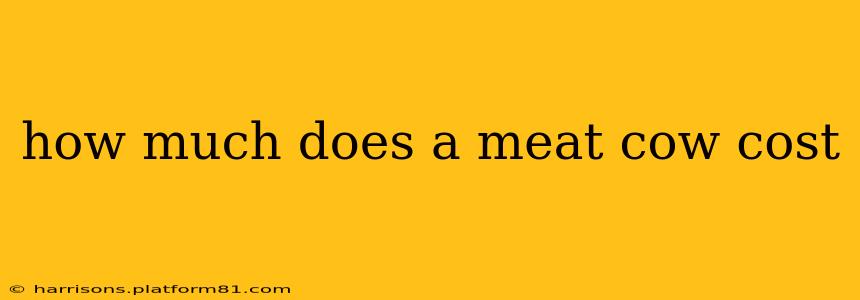The cost of a meat cow, also known as a beef cow or feeder calf, varies significantly depending on several factors. There's no single answer to this question, but understanding these factors will help you determine a realistic price range. This guide will explore the key influences on cost and provide you with the information needed to make an informed decision.
What Factors Determine the Price of a Meat Cow?
Several crucial elements affect the final price you'll pay for a meat cow:
-
Breed: Different breeds have varying market values. Popular beef breeds like Angus, Hereford, and Simmental often command higher prices due to their desirable traits like marbling, growth rate, and carcass yield. Less common or specialized breeds might be cheaper.
-
Age and Weight: The price per pound generally decreases as the animal gets older and heavier. A young, lightweight calf will cost more per pound than a mature, heavier steer ready for slaughter. Buyers often consider the cost per pound of gain, factoring in the expected weight gain before slaughter.
-
Sex: Steers (castrated males) are typically preferred for meat production due to their more tender and flavorful meat. Heifers (young females) are usually cheaper but might require more time and resources to reach slaughter weight. Bulls (uncastrated males) are generally the least expensive but their meat is often tougher and less desirable.
-
Health and Condition: A healthy animal with good conformation (body structure) will always command a higher price than one with health issues or poor conformation. Veterinary records and visual inspection are crucial in determining a fair price.
-
Location and Market Demand: Prices fluctuate based on geographical location and current market demands. Regional differences in feed costs, transportation expenses, and consumer preferences all impact pricing. Seasonal variations also influence prices.
-
Seller: Private sellers, auction markets, and feedlots all have different pricing structures. Auction markets offer competitive pricing, while private sellers may negotiate prices based on individual circumstances. Feedlots typically sell animals in larger groups, impacting the overall price per head.
How Much Can I Expect to Pay?
Providing an exact figure is impossible without specifying the above factors. However, here's a general overview:
-
Calves (under 1 year): These can range from a few hundred dollars to several thousand, depending on breed, weight, and quality.
-
Yearlings (1-2 years): Prices will be higher than calves, potentially ranging from several thousand to tens of thousands of dollars, reflecting their increased weight and closer proximity to slaughter weight.
-
Mature Cows (ready for slaughter): These can vary widely depending on weight and condition but generally cost several hundred to several thousand dollars. The price is often quoted per pound of live weight.
It's vital to research local market prices before purchasing. Check with local auction barns, livestock producers, and agricultural agents to get a realistic estimate for your region.
What are the Additional Costs Involved in Raising a Meat Cow?
The initial purchase price is just the beginning. Consider these ongoing expenses:
-
Feed: This is typically the largest recurring cost. Feed costs depend on the type of feed (hay, grain, pasture), the animal's growth stage, and the overall market price of feedstuffs.
-
Veterinary Care: Routine checkups, vaccinations, and treatments for illnesses will add to the total cost.
-
Housing and Land: If you don't have sufficient pasture, you'll need to consider the cost of housing and land.
-
Labor: The time and effort spent caring for the animal represent a significant cost, often overlooked.
Where Can I Find Meat Cows for Sale?
Several avenues exist for purchasing meat cows:
-
Local Auctions: These are often the most cost-effective way to buy livestock.
-
Private Sellers: Connecting with local farmers or ranchers directly can lead to personalized negotiations.
-
Feedlots: These facilities typically sell in bulk, providing economies of scale but less individual negotiation.
What are the Different Types of Meat Cows?
The breed of the cow heavily influences its cost and suitability for meat production. Research various breeds (Angus, Hereford, Charolais, etc.) to determine which best suits your needs and budget.
By considering these factors, you'll be better equipped to estimate the cost of a meat cow and make a sound financial decision. Remember to always conduct thorough research and seek advice from experienced livestock professionals before making a purchase.
